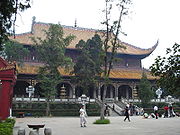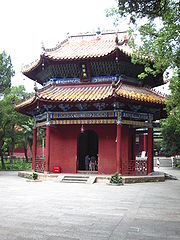
Grand Temple of Mount Heng
Encyclopedia

Chinese character
Chinese characters are logograms used in the writing of Chinese and Japanese , less frequently Korean , formerly Vietnamese , or other languages...
南岳大庙) is located at the foot of Mount Heng
Mount Heng (Hunan)
Mount Heng , also known as Nan Yue , is located in Hunan Province, People's Republic of China and is one of the Five Sacred Mountains of Taoism in China. Heng Shan is a mountain range long with 72 peaks and lies at 27.254798°N and 112.655743°E...
, and on the north of ancient town of Mount Heng. It is the largest temple on Mount Heng. It is a major component of Mount Heng National Key Tourist Resort Zone.
History
The Grand Temple was initially called Heaven Governor Huo King Temple (司天霍王庙), and later, the name changed to South Heaven Genuine Master Temple (南天真君祠). Its founding year is unknown. The earliest documented records show that it was built in Kaiyuan 13th year (AD. 725) of Tang DynastyTang Dynasty
The Tang Dynasty was an imperial dynasty of China preceded by the Sui Dynasty and followed by the Five Dynasties and Ten Kingdoms Period. It was founded by the Li family, who seized power during the decline and collapse of the Sui Empire...
. The temple experienced Song
Song Dynasty
The Song Dynasty was a ruling dynasty in China between 960 and 1279; it succeeded the Five Dynasties and Ten Kingdoms Period, and was followed by the Yuan Dynasty. It was the first government in world history to issue banknotes or paper money, and the first Chinese government to establish a...
, Yuan
Yuan Dynasty
The Yuan Dynasty , or Great Yuan Empire was a ruling dynasty founded by the Mongol leader Kublai Khan, who ruled most of present-day China, all of modern Mongolia and its surrounding areas, lasting officially from 1271 to 1368. It is considered both as a division of the Mongol Empire and as an...
, Ming
Ming Dynasty
The Ming Dynasty, also Empire of the Great Ming, was the ruling dynasty of China from 1368 to 1644, following the collapse of the Mongol-led Yuan Dynasty. The Ming, "one of the greatest eras of orderly government and social stability in human history", was the last dynasty in China ruled by ethnic...
and Qing
Qing Dynasty
The Qing Dynasty was the last dynasty of China, ruling from 1644 to 1912 with a brief, abortive restoration in 1917. It was preceded by the Ming Dynasty and followed by the Republic of China....
Dynasties, having suffered six fires and undergone 16 large-scale renovations. At the end of Ming Dynasty, the temple was burnt in the war. In Guangxu 8th year (1882) of Qing Dynasty, the temple was rebuilt following the layout of Forbidden City
Forbidden City
The Forbidden City was the Chinese imperial palace from the Ming Dynasty to the end of the Qing Dynasty. It is located in the middle of Beijing, China, and now houses the Palace Museum...
in Beijing
Beijing
Beijing , also known as Peking , is the capital of the People's Republic of China and one of the most populous cities in the world, with a population of 19,612,368 as of 2010. The city is the country's political, cultural, and educational center, and home to the headquarters for most of China's...
, thus it was also called "Little Palace in South China". The majority of the buildings have been preserved till today. During Cultural Revolution
Cultural Revolution
The Great Proletarian Cultural Revolution, commonly known as the Cultural Revolution , was a socio-political movement that took place in the People's Republic of China from 1966 through 1976...
, the temple was regarded as engendering the values of the "Four Olds
Four Olds
The Four Olds or the Four Old Things were Old Customs, Old Culture, Old Habits, and Old Ideas. One of the stated goals of the Cultural Revolution in the People's Republic of China was to bring an end to the Four Olds...
", and suffered extensive damage. The stone tablets, inscribed boards, Buddhist statues and scripts were all destroyed. Starting in 1980s, continuous renovation projects have rehabilitated destructed buildings and statues.
Architecture

The name of Lingxing Gate means abundant talents emerge and serve the country. Usually, "Lingxing" wouldn't be used to name a temple gate. There're only two exceptions in China, and the other Lingxing Gate is in Temple of Confucius
Temple of Confucius
A Temple of Confucius or Confucian temple is a temple devoted to the memory of Confucius and the sages and philosophers of Confucianism.- History :...
. Kuixing Pavilion is also called "Panlong Pavilion" (literally, Circling Dragon Pavilion). It has double-eave two-curve roof and covers 139 m2. It serves as an opera stage.
There is a tablet in Imperial Tablet Pavilion bestowed by emperor Kangxi, on which "Temple of Mount Heng Renovation Memorial" was inscribed, comprising 279 characters written by the emperor himself. The first sentence reads, "Mount Heng is the giant pillar in South. It corresponds to Star Yu Heng of Big Dipper
Big Dipper
The Plough, also known as the Big Dipper or the Saptarishi , is an asterism of seven stars that has been recognized as a distinct grouping in many cultures from time immemorial...
, and is also called Mount Longevity." Mount Heng's another name, Mount Longevity, was thereafter determined by the authority. The original tablet was destroyed in the Cultural Revolution.
Culture
Three religions, Buddhism, Taoism and Confucius, co-exist in the Grand Temple of Mount Heng. Eight Temples of Taoism, Eight Temples of Buddhism and Imperial Library Tower represent the convergence of three religions. The temple enjoys great popularity among devotees. Large Buddhist festivals are held in Buddhist holidays each year. Pilgrims come not only from nearby Hunan and GuangdongGuangdong
Guangdong is a province on the South China Sea coast of the People's Republic of China. The province was previously often written with the alternative English name Kwangtung Province...
, but also from Hong Kong
Hong Kong
Hong Kong is one of two Special Administrative Regions of the People's Republic of China , the other being Macau. A city-state situated on China's south coast and enclosed by the Pearl River Delta and South China Sea, it is renowned for its expansive skyline and deep natural harbour...
, Macao
Mação
Mação is a municipality in Portugal with a total area of 400.0 km² and a total population of 7,763 inhabitants.The municipality is composed of eight parishes, and is located in the Santarém District....
, Southeast Asia and Japan
Japan
Japan is an island nation in East Asia. Located in the Pacific Ocean, it lies to the east of the Sea of Japan, China, North Korea, South Korea and Russia, stretching from the Sea of Okhotsk in the north to the East China Sea and Taiwan in the south...
. There was originally a statue of Mountain God (Yue Shen) in the Grand Hall, to which the past emperors all paid tribute. In early Tang Dynasty, the god was designated "Heavenly Governor Huo King". In Kaiyuan years of Tang, it was titled "Genuine Master of Mount Heng". In Song Dynasty, it was named "Heavenly Governor Zhaosheng Emperor". Today, the existent "Superior Emperor of Mount Heng" was rebuilt in 1983, for the original statue was destroyed in the Cultural Revolution. There are also two "Treasury Houses" on each side of the Grand Hall. Facing from the hall, the one on the left side is designed for worship by living people, while the one on the right hosts the name boards of the deceased.
In 1990, the Chinese National Post Bureau issued a series of Mount Heng stamps (T155), comprising 4 pieces. The first one, "Grand Temple", depicted this temple.

